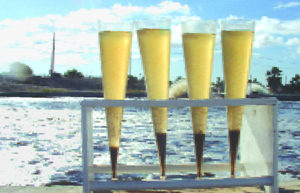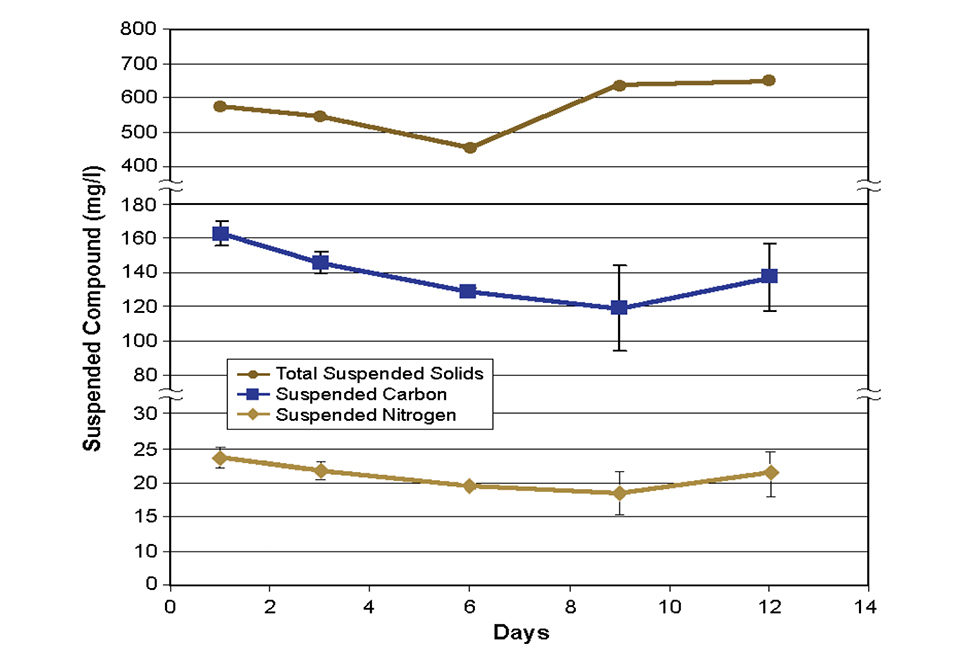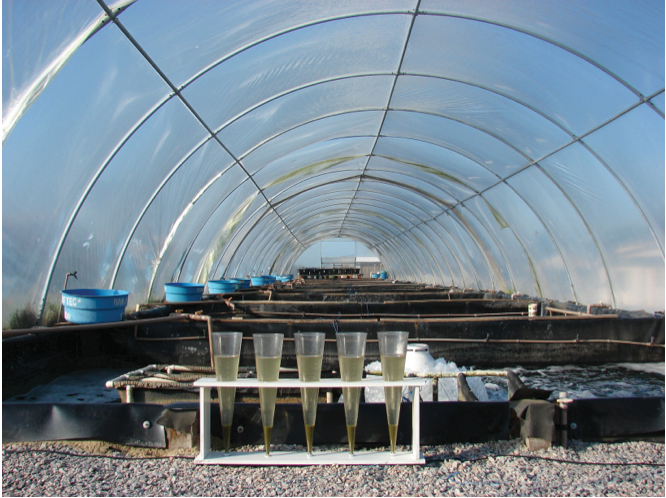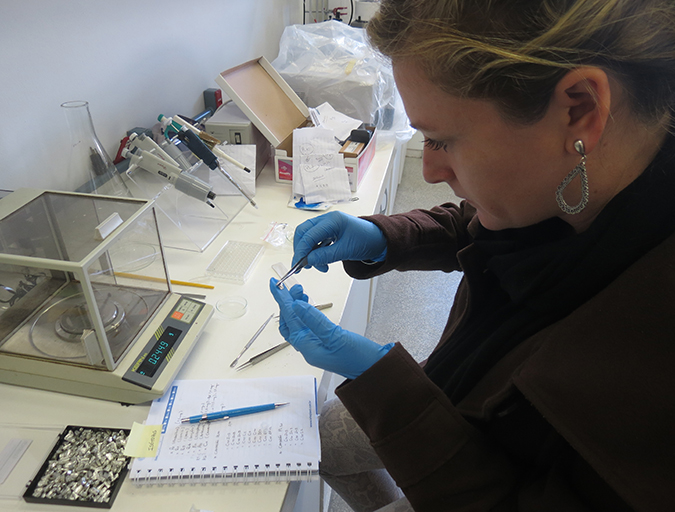Pacific Aquafarms research focused on quantifying uptake of microbial flocs

Water quality management in active suspension ponds is based upon developing and controlling dense heterotrophic bacteria in the pond water column, and happens concurrently with zero or minimal water exchange. Bacteria utilize uneaten feed and uptake inorganic nitrogen from the water to produce microbial protein in systems where the carbon per nitrogen ratio is high. Excessive ammonium and nitrite levels can thus be prevented. In addition, feed nutrients recycled by the microbial community – and harvested by the fish, mostly as high-value feed in the form of microbial flocs – can double the utilization of protein and improve feed utilization.
Active suspension systems
The principles of growing fish or shrimp in intensive ponds with limited water exchange were developed simultaneously in the United States and Israel during the early 1990s. Since then, significant research and many commercial active suspension systems have been undertaken, primarily for shrimp production.
The biomass in fish-producing active suspension ponds can range 10-40 kilograms per m3, compared to 1-2 kilograms per m3 in shrimp ponds. Thus, process rates and concentrations of various compounds in fish ponds are higher than in shrimp ponds.
Floc uptake study
Research at Pacific Aquafarms, located in the Imperial Valley of California, USA, focused on quantifying the microbial flocs uptake of fish. The material balance of suspended components and the flow of a nitrogen isotope into the fish during a two-week experimental period were used to evaluate the uptake.
Within the production farm of 20 lined grow-out ponds, a 1,000-m2 research pond with 3-ppt salinity water from a thermal water aquifer was stocked in May 2004, with 41,000 tilapia, (Tilapia mossambica), that averaged 47 g. They reached a mean market weight of 463 g in 110 days.
The pond was aerated with paddlewheels to promote a circulating current. Pond water exchange during the test was limited to about 6 percent per day, and sludge that accumulated in the pond center was removed daily via a central drain. A 20 percent-protein feed was used to minimize ammonia accumulation and maximize protein utilization. Total ammonium nitrogen (TAN) concentrations in the water were determined twice weekly. Starch was added at 45 kilograms per day whenever TAN concentrations rose excessively.
Experimental tanks
Three 1-cubic-meter fiberglass tanks were placed near the experimental pond and filled in September 2004 with pond water. Air stones were placed to ensure proper aeration and mixing of the water. Ammonium chloride tagged with a nitrogen isotope (60 percent 15N enrichment) and dissolved in water, and 100 grams of starch in suspension were added to the tanks to enhance the assimilation of the added ammonium into the microbial biomass. Two days later, an additional 50 grams of starch were added to each tank.
Total ammonium concentration in the tanks was reduced to very low values, indicating the tagged ammonium was transformed into microbial biomass. Twenty fish with an average weight of 107 grams were introduced to each tank, but not initially fed. During a six-day period, the only feed source was the microbial suspension. From day 7 to the end of the experiment on day 14, feed was added at a daily rate of 2 percent body weight. No fish mortality was detected.
Floc volume
Floc volume was determined by sampling pond water in a series of Imhoff cones. The volume increased during the two days prior to fish stocking, a period when rather high levels of starch were added to the tanks. Subsequently, there was a clear reduction in the floc volume in the six days when feed was not given, from about 30 to 20 millimeters per liter. From day 6 onward, floc volume rose to a relatively stable level of about 27 millimeters per liter.
Ten replicated samples of settled flocs were collected on days 6 and 12 of the experimental period. The floc plugs contained 1.4 percent dry solids. Using these results, the daily drop of floc volume was 24.3 mg dry matter millimeters per liter.
Suspended compounds
Total suspended solids (TSS), suspended carbon, and suspended nitrogen concentrations during the experimental period are presented in Figs. 1 and Table 1. TSS dropped about 20 milligrams per liter per day during the no-feed part of the experiment from an initial value of 582 to 460 milligrams per liter. When feed was applied, TSS increased to 643 millimeters per liter.

Avnimelech, Daily decrease of total suspended solids (TSS), Table 1
| Parameter | TSS | Floc Volume | Carbon | Nitrogen |
|---|---|---|---|---|
| Daily measured change (mg/l) | 20 | 1.74 | 6.61 | 0.87 |
| Equivalent dry SS change (mg/l) | 20 | 24.3 | 26.9 | 23.5 |
| Daily uptake by a single 107-g fish as equivalent suspended solids (g/fish) | 0.954 | 1.154 | 1.18 | 1.034 (39 mg nitrogen, 0.25 g protein) |
| Daily uptake of nitrogen by a single 107-g fish determined through 15N accumulation | 44.4 mg nitrogen/fish, 0.287 g protein/fish |
TSS, carbon, and nitrogen concentrations decreased during the nonfed period. An increase of these components started slowly from day 9 onward. The average carbon contents of the suspended solids was 24.6 ± 4 percent, and that of suspended nitrogen was 3.7 ± 0.55 percent. The average carbon per nitrogen ratio in the suspended matter was a rather uniform 6.6, with a coefficient of variation of only 2.3 percent.
The drops in suspended carbon and nitrogen can be related to the decrease of TSS during the nonfed period as a means to compare the different parameters. The corresponding daily TSS decrease, calculated using the daily rates of carbon and nitrogen decrease, was 26.9 or 23.5 milligrams per liter, respectively, as shown in Table 1.
The enrichment of 15N in the fish is presented in Fig. 2. The 0.37 percent isotope enrichment on the first day of the experiment represents the natural enrichment of the fish before exposure to the tagged suspension. Later on, 15N percentage increased with time, with the rate of increase diminished with time.

Lower feed rations, cost
The use of a nitrogen-labeled flocs system allows the following of microbial protein utilization in the absence and presence of added feed. It seems the process was based upon the filtration of water, and depended on the concentration of flocs in the water, the filtration efficiency of different fish, and possibly factors such as floc size distribution.
The recycling of feed material, specifically feed protein, permits lowering the feed ration and protein content in feed, thus lowering the costs of fish production. The recycling of protein and lower demand for external protein sources are important environmental considerations.
Special formulations that take into account the uptake of microbial proteins by the fish is needed for ASP ponds. These feeds will be less expensive than conventional ones.
(Editor’s Note: This article was originally published in the October 2005 print edition of the Global Aquaculture Advocate.)
Now that you've reached the end of the article ...
… please consider supporting GSA’s mission to advance responsible seafood practices through education, advocacy and third-party assurances. The Advocate aims to document the evolution of responsible seafood practices and share the expansive knowledge of our vast network of contributors.
By becoming a Global Seafood Alliance member, you’re ensuring that all of the pre-competitive work we do through member benefits, resources and events can continue. Individual membership costs just $50 a year.
Not a GSA member? Join us.
Author
-
Yoram Avnimelech, Ph.D.
Department of Civil and Environmental Engineering
Technion, Israel Institute of Technology
Haifa, Israel, 32000[108,105,46,99,97,46,110,111,105,110,104,99,101,116,46,120,116,64,109,97,114,111,121,103,97]
Tagged With
Related Posts

Health & Welfare
Ammonia addition enhances microbial flocs in nursery phase for Pacific white shrimp
In a study, “pre-fertilization” in the nursery phase of a biofloc system for shrimp was tested. The objective was to accelerate the biofloc formation to minimize ammonia concentrations, avoiding high peaks during culture.

Health & Welfare
A holistic management approach to EMS
Early Mortality Syndrome has devastated farmed shrimp in Asia and Latin America. With better understanding of the pathogen and the development and improvement of novel strategies, shrimp farmers are now able to better manage the disease.

Aquafeeds
Biofloc consumption by Pacific white shrimp postlarvae
The stable isotopes technique with δ13C and δ15N can be used to determine the relevance of different food sources to shrimp feeding during the pre-nursery phase of Litopenaeus vannamei culture. During this trial, different types of commercial feed, microalgae, Artemia sp. nauplii and bioflocs were used as food sources.

Health & Welfare
10 paths to low productivity and profitability with tilapia in sub-Saharan Africa
Tilapia culture in sub-Saharan Africa suffers from low productivity and profitability. A comprehensive management approach is needed to address the root causes.


